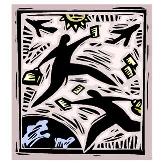SAPEI är italienska Ternas senaste stora projekt. Det är en HVDC Classic med sjökabel som kopplar samman fastlandet strax söder om Rom med Sardinien. Terna anlitade ABB och Prysmian för att leverera HVDC-stationerna respektive sjökabeln.

Bild lånad från Terna.
Att stationen slutligen är igång tycker jag personligen är verkligt intressant, dels för att jag själv varit en del av processen. När jag under en av arbetsperioderna under min utbildning arbetade jag vid ABB HVDC:s avdelning för kontrollsystem och var ansvarig för framtagning av utbildningsmaterial för Ternas personal. I slutet av september 2009 befann jag mig tre veckor nere i Italien på båda siter (stationer) och föreläste – en riktig upplevelse som jag skrivit om tidigare under min förra bloggadress.
Det stora med projektet är dock sjökabeln. Sjökabeln som levererades av Prysmian, ett ledande kraftkabel företag, är ett genombrott på flera punkter. Det är den hittills längsta kraftkabeln för sjöläggning som har så hög effekt som 1 000 MW (därmed också den kraftfullaste kabeln på 500 kV). Kraftlänken som binder samman fastlandet med Sardinien är tänkt att huvudsakligen transportera överbliven vindkraft från Sardinien istället för att Italien skall behöva importera kraft från angränsande länder. Att Terna tog på sig denna utmaning har således lett till den första förläggningen av sjökabel på ett havsdjup på över 1 500 m (1 640 m specifikt).
Mer information om SAPEI återfinns på Ternas tillägnade hemsida: SAPEI.it (English)
________________________________________________________________
SAPEI is the HVDC Classic cable link between the Italian mainland and Sardinia. The cable between the two stations have boasted many records: (1) It is the longest power sea cable at 1000 MW, (2) it is the deepest in the world at 1 640 m, (3) it is the most powerful 500 kV cable, and it connects the two largest converter stations in Italy.
More information regarding the SAPEI project can be found at Ternas dedicated homepage: SAPEI.it (English)

 Jag älskar att läsa engelska naturvetenskapliga texter – speciellt från USA. Det gäller inte bara ”populärvetenskapliga” böcker, även kurslitteratur är betydligt bättre – både i upplägg och innehåll. Amerikanare vet hur man gör ett ämne intressant.
Jag älskar att läsa engelska naturvetenskapliga texter – speciellt från USA. Det gäller inte bara ”populärvetenskapliga” böcker, även kurslitteratur är betydligt bättre – både i upplägg och innehåll. Amerikanare vet hur man gör ett ämne intressant.








